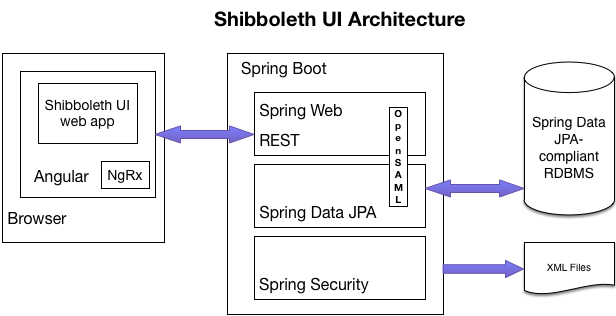Project Resources Wiki
Project Overview
A GUI (Graphical User Interface) is being developed for the Shibboleth IdP, funded by Internet2/Trust and Identity and Unicon and with the guidance of community architects including Scott Cantor, whose initial focus is on managing metadata and metadata filters (using entity attributes).
Why metadata? One of the primary reasons that the Shibboleth IdP is so widely adopted is its ability to leverage metadata, including large metadata aggregates found in many of the eduGAIN member federations, to support large-scale multilateral federated identity. The Shibboleth development team, in accordance with increasing community needs, is expanding the range of behaviors/settings of the Shibboleth IdP that can be controlled through metadata. In particular, as part of the next release of the Shibboleth IdP version 3.4, support is added for entity attributes that can trigger various relying party override settings.
The Shibboleth IdP already supports the ability to craft attribute release (filter) rules that are triggered by entity attribute settings, and other settings (such as NameID ones) can be similarly "activated".
This new Shibboleth UI already enables the Identity Administrator to create Service Provider (SP) metadata files from "scratch", or import metadata for an SP from a file or URL, and add entity attributes to those metadata that may impact relying party settings such as required authentication context, what is signed, signature algorithm, encryption, etc. Moreover, if the Identity Administrator adds the right template to the attribute-filter.xml file, the UI also enables the management of which attributes may be released to that SP. The current work on the Shibboleth UI is now focused on enabling the Identity Administrator to similarly add entity attributes to specific SPs from the InCommon metadata aggregate by creating metadata filters that will "annotate" that core InCommon-provided SP metadata. Through these filters, aspects of the IdP's behavior and how and what is contained within the SAML response to a given SP, can be managed thru the UI.
Further iterations of the Shibboleth UI are planned, which will continue to expand on the range of metadata source and filter types supported thru the UI, and allow defining and managing custom entity attributes. How the UI expands beyond that is a conversation for the community to have as this work moves forward.
Architecture
The Shibboleth UI is written as a Spring Boot application, with Angular used for the front-end (UI). And it relies on a persistent relational database for storing the configuration data created through the UI, and then writes out XML files to disk. The XML files include the individual metadata sources (files) being managed through the UI, which by default will be written into a generated/ directory with filenames of the SHA1 hash of the entityId. And it will write out a metadata-providers.xml file that contains all metadata providers defined through the UI, along with any filters that have been created for of those metadata providers.
Deployment
There is a TIER Docker Shibboleth UI testbed deployment one can use, that provides the full environment one needs to explore and gain experience with the Shibboleth UI. This Dockerized testbed version is available at https://github.internet2.edu/docker/shib-ui . That testbed follows the TIER packaging guidelines. It relies on supervisord, and includes the Shibboleth UI, a Shibboleth IdP (with a shared filesystem between the Shibboleth UI and Shibboleth IdP), an LDAP server as the base credential/attribute store for the IdP, the TIER Maria DB image for the UI's persistent database, and the TIER Beacon configuration.
Beyond becoming familiar with the Shibboleth UI by using the testbed, note that the Shibboleth UI has been built to be deployed as its own web app. It would run in the same servlet engine as the IdP, or it could run in a separate one. The key link is that files generated by the UI need to end up making it into the IdP's configuration (conf/) directory, however you want to make that happen. That could be a NFS/SMB file sharing approach, it could be rsync or scp or something similar, or you could put the files into a repo and then pull out of the repo into the IdP. Here is the info within the README of the repo:
shibui
For more information, see docs
Requirements
- Java 8 (note that ONLY Java 8 is supported at this time)
Running
There are currently 2 ways to run the application:
- As an executable
- deployed in a Java Servlet 3.0 container
Note that some features require encoded slashes in the URL. In tomcat (which is embedded in the war), this can be allowed with:
In Apache HTTPD, you'll need something like:
Running as an executable
java -jar shibui.war
For complete information on overriding default configuration, see [https://docs.spring.io/spring-boot/docs/current/reference/html/boot-features-external-config.html].
Deploying as a WAR
The application can be deployed as a WAR file in a Java Servlet 3.0 container. Currently, the application must be run in the root context.
To override default configuration, see [https://docs.spring.io/spring-boot/docs/current/reference/html/boot-features-external-config.html]. The easiest way to do this in a servlet container is through the use of system properties
Authentication
Currently, the application is wired with very simple authentication. A password for the user user can be set with the shibui.default-password property. If none is set, a default password will be generated and logged:
Default Properties
This is a reflection of the default application.properties file included in the distribution. Note that lines beginning with # are commented out.
Additional resources
Shibboleth Metadata Management GUI - Requirements
